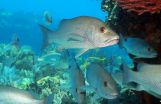(Press-News.org) AUDIO:
These are gray snapper larval growls recorded in the field.
Click here for more information.
MIAMI – A new study from researchers at the University of Miami (UM) Rosenstiel School of Marine and Atmospheric Science is the first to document that fish larvae produce sound. These "knock" and "growl" sounds may help small larvae maintain group cohesion in the dark.
"Although many adult fishes produce sounds, no one has previously considered that larvae, too, may be sound producers. This is the first study to show that fish larvae have an acoustic repertoire," said Claire Paris, UM Rosenstiel School associate professor of ocean sciences. "This is a true discovery as it reveals the existence of a communication system for young fish larvae."
The UM Rosenstiel School research team set up both field and laboratory experiments to listen to larval gray snapper, Lutjanus griseus, an economically valuable fish that spend their first 30 days of life as pelagic larva before settling in shallow seagrass beds.
In the field experiment, the scientists set a drifting in situ chamber, called DISC, equipped with audio and video recording systems, near Fowey Rocks lighthouse in the northern Florida Keys to record larval orientation behavior in the pelagic environment. In total 58 deployments were conducted, 27 during the day and 31 at night. The team also recorded sounds in a laboratory setting to confirm that the sounds observed in the field were from gray snapper larvae. The researchers also referred to the public sound archive at the Macaulay Library to compare the larval sounds to those produced by adult L. griseus.
The researchers observed that larvae produced "knocks" and "growls" in the range of 200–800 Hz, which is within the hearing range of most adult fish. The fish larvae produced these sounds during 70% of the nighttime trials, and none of the daytime trials. The gray snapper larvae used in the study arrived in a large group over the span of a few hours, suggesting that these acoustic signals may provide a mechanism for these larvae to maintain group cohesion during their pelagic journey.
"The study was setup to record ambient sounds around the drifting arena that might guide the fish larval orientation. It was a fantastic surprise to listen to the recording and hear that the larva itself was emitting sound," said Paris. "Communication between larvae could allow them to maintain group cohesion, which is critically important for faster swimming, finding navigational signals and settlement cues, and better survival during the pelagic phase."
The paper, titled "First evidence of fish larvae producing sounds," was published in the Oct. 1 issue of the journal Biology Letters. The study co-authors include: Erica Staaterman, Claire Paris, and UM Rosenstiel School graduate student Andrew Kough.
"This discovery has important conservation implications as well," said Erica Staaterman, UM Rosenstiel School Ph.D. student and lead author of the paper. "As anthropogenic noise in the marine environment continues to increase, it is important to understand potential impacts on these previously undiscovered acoustic communication systems."
INFORMATION:
About the University of Miami's Rosenstiel School
The University of Miami is one of the largest private research institutions in the southeastern United States. The University's mission is to provide quality education, attract and retain outstanding students, support the faculty and their research, and build an endowment for University initiatives. Founded in the 1940's, the Rosenstiel School of Marine & Atmospheric Science has grown into one of the world's premier marine and atmospheric research institutions. Offering dynamic interdisciplinary academics, the Rosenstiel School is dedicated to helping communities to better understand the planet, participating in the establishment of environmental policies, and aiding in the improvement of society and quality of life. For more information, visit: http://www.rsmas.miami.edu.
For decades, research has generally focused on individual, family and peer factors to explain illicit drug use, neglecting neighborhood factors as a cause. While the scant previous research on neighborhood factors and illicit drug use has focused on facets such as crime and socio-demographic characteristics, none has explored the associations between the perceived frequency of drug sales, drug use, and peer attitudes towards drug use. Now a study out of New York University's Center for Drug Use and HIV Research (CDUHR), address this paucity in the research.
Published ...
Schizophrenia and bipolar disorder both appear to be associated with dendritic spine loss in the brain, suggesting the two distinct disorders may share common pathophysiological features, write author Glenn T. Konopaske, M.D., and colleagues at McLean Hospital, Belmont, Mass., and Harvard Medical School, Boston.
The dendritic spines play a role in a variety of brain functions. Previous studies have observed spine loss in the dorsolateral prefrontal cortices (DLPFCs) from individuals with schizophrenia (SZ). To determine whether spine pathology happens in individuals with ...
EAST LANSING, Mich. --- New research suggests dear old Mom and Dad could be the auto industry's secret weapon.
The study, co-authored by Michigan State University economist Soren Anderson, found children are 39 percent more likely to buy a particular brand of automobile if their parents bought that brand.
This surprisingly strong correlation could have implications for automakers' marketing efforts. In absence of this inherited brand loyalty, a sensible strategy might be to "invest in young consumers and harvest old consumers" – that is, lower prices on entry-level ...
A group of researchers from Switzerland has thrown light on the precise mechanisms responsible for the impressive ability of nanoparticles to detect fingermarks left at crime scenes.
Publishing their results today, 2 October, in IOP Publishing's journal Nanotechnology, the researchers have provided evidence contesting the commonly accepted theory that nanoparticles are attracted to fingermarks electrostatically.
The attraction, they claim, is in fact chemical and is caused by compounds on the surface of nanoparticles bonding with a complex cocktail of compounds present ...
People who are prone to delusions gather insufficient information before making decisions, according to research published in the journal Psychological Medicine.
Researchers from Royal Holloway, University of London, led by PhD student Leslie van der Leer, assigned participants a computer task in which they observed the colour of a black or white fish caught from one of two lakes and were then asked to choose to see further fish or decide on one of the lakes as the source of that sequence of fish.
Each participant was rewarded for choosing the correct lake but costs ...
Recruiting health workers with high levels of internal motivation is critical for work in difficult conditions, where their personal security and health might be compromised, according to new research published today in Health Policy and Planning.
Health workers often witness the deaths of friends and colleagues during conflict situations and also face abduction, injury and death, themselves. Life history interviews with 26 health workers who lived through conflict in Northern Uganda reveal their resilience and how they coped by building trusting relationships with the ...
A unique collection of studies exploring the theme of the Third Global Symposium on Health Systems Research has been published today in a supplement to Health Policy and Planning.
This collection of studies on 'the science and practice of people-centred health systems' presents the latest in the field of health policy and systems research, bringing together research from Ethiopia, Uganda, Ghana, Nigeria, South Africa, India, Argentina and Brazil. The eleven studies comprising the supplement employ a range of methods to investigate different aspects of people-centred health ...
Some sharks are 'gregarious' and have strong social connections, whilst others are more solitary and prefer to remain inconspicuous, according to a new study which is the first to show that the notorious predators have personality traits.
Personalities are known to exist in many animals, but are usually defined by individual characteristics such as how exploratory, bold or aggressive an individual is.
Research led by the University of Exeter and the Marine Biological Association of the UK (MBA) has shown for the first time that individual sharks actually possess social ...
Evolocumab, an injected form of a new class of drugs called PCSK9 inhibitors[1], is highly effective at reducing low-density lipoprotein (LDL) or "bad cholesterol" levels with few side effects in people with familial hypercholesterolaemia (FH), an inherited condition that causes extremely high cholesterol and high risk of cardiovascular disease at an early age.
Published in The Lancet, the results of two of the largest global randomised trials ever undertaken in this field found that evolocumab rapidly cut levels of LDL cholesterol by on average 60% more than those given ...
How can parents with the autoimmune disorder celiac disease prevent or delay the condition's development in their children? The results of an international study led by investigators associated with the Center for Celiac Research and Treatment at MassGeneral Hospital for Children (MGHfC) challenge some of the current thinking on possible measures to take. The report in the Oct. 2 New England Journal of Medicine finds that loss of tolerance to gluten – a protein composite found in wheat, rye and barley – is a dynamic process and that neither breastfeeding or delaying the ...


